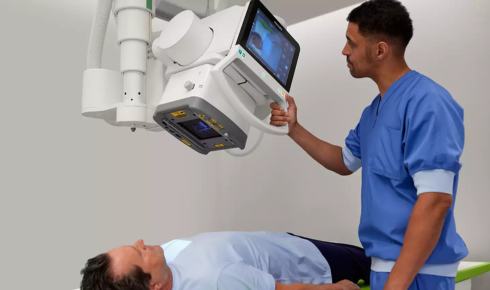
In modern radiology departments, imaging demands differ across settings. A radiology suite, intensive care unit, or emergency room each has unique challenges. Agfa’s lineup of digital radiography systems namely DR400i, DR Mobile, and DR 100s offers tailored solutions that deliver diagnostic image quality, streamlined workflow, and the flexibility to suit each environment.
DR400i: High-Efficiency Fixed Room Imaging
The DR400i is Agfa’s solution for dedicated radiography rooms. It is a floor-mounted system that avoids the need for ceiling rails or overhead supports. Its design emphasizes easy installation and flexibility. The system offers motorized vertical tracking for the tube head, a floating tabletop, and a height-adjustable wall stand. These features facilitate rapid patient positioning and efficient examinations.
This system supports one or two detectors, which allows scaling to suit patient volume. With Agfa’s MUSICA image processing baked in, images are automatically optimized for contrast, sharpness, and noise suppression. This reduces manual post-processing and minimizes the need for repeat exposures. The DR400i is ideal for outpatient imaging centers or hospital radiology suites where throughput, consistency, and reliability are priorities.
DR Mobile: Imaging at the Point of Care
There are many cases where moving a patient to the radiology room is impractical or risky. In such situations, DR Mobile systems bring imaging to the bedside. These mobile units are compact, maneuverable, and built for hospital corridors and care wards. The wireless detectors reduce handling complexity and speed up exams.
With DR Mobile, technologists can acquire and preview images immediately at the patient’s side. Integration with the hospital’s PACS or RIS ensures that images reach radiologists without delay. By eliminating patient transport, DR Mobile helps reduce interruptions in patient care and minimize transfer risk. It is especially useful in ICU, emergency, or perioperative settings.
DR 100s: Premium Mobile Radiography for All Environments
For facilities requiring advanced mobile imaging with more automation and power, the DR 100s is a high-performance choice. It combines mobility with system features typically reserved for fixed rooms. The narrow profile and telescopic column allow navigation through tight spaces and crowded wards. Its motorized movement makes positioning easier and more precise.
The DR 100s supports a wide range of exams, including chest, skeletal, abdominal, and even full leg or full spine imaging via stitching. Its SmartXR assist tools guide technologists with positioning, exposure settings, and workflow support. The embedded MUSICA image processing engine ensures that every image is optimized automatically before review.
Additionally, DR 100s is equipped for continuous use with long battery life and reliable wireless connectivity. It gives clinicians the flexibility to handle urgent imaging needs wherever the patient is located.
Choosing the Right System for Your Needs
When selecting among DR400i, DR Mobile, and DR 100s, consider these key factors:
- Imaging location: Fixed rooms favor DR400i; bedside or ward imaging needs demand DR Mobile or DR 100s.
- Volume and exam variety: DR400i handles high throughput; DR 100s supports complex exam types in mobile settings.
- Mobility challenges: DR Mobile and DR 100s shine in tight corridors, busy wards, or isolation areas.
- Workflow integration: All systems support Agfa’s imaging ecosystem with seamless connectivity, image optimization, and dose management.
Each system supports high-quality flat panel detectors, automatic image enhancement, and hospital network integration. They help reduce the need for repeat scans while improving throughput and diagnostic confidence.
Conclusion
Agfa’s DR400i, DR Mobile, and DR 100s systems provide imaging flexibility for a diverse range of care settings, including fixed radiology suites, patient wards, and mobile diagnostics. By selecting a system that aligns with your clinical needs and space constraints, you can deliver faster diagnoses, reduce patient movement, and maintain consistent image quality across your radiology operations.


